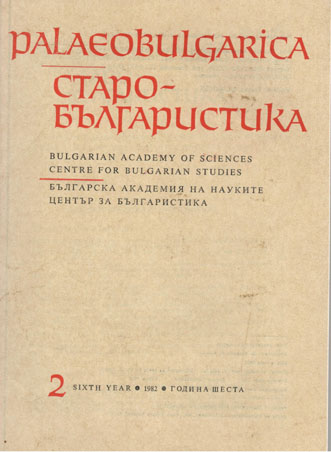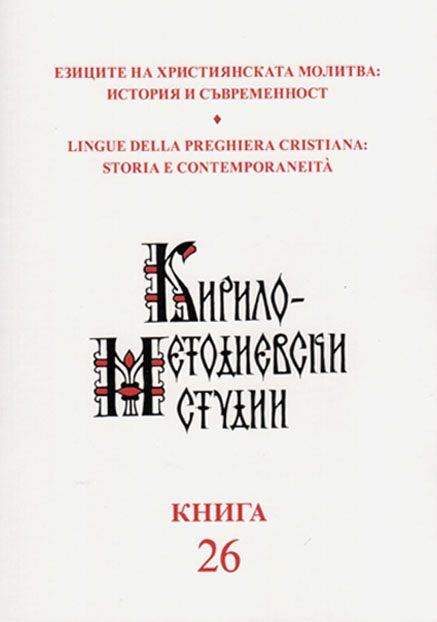
We kindly inform you that, as long as the subject affiliation of our 300.000+ articles is in progress, you might get unsufficient or no results on your third level or second level search. In this case, please broaden your search criteria.






The long passage from the first Letter to the Corinthians, quoted in the Life of Constantine Cyril (in particular 1 Cor.14, 19), deals with a fundamental theme of the Cyril-Methodian mission, "speaking in tongues" and teaching. The paper examines this theme, present in the Cyril-Methodian sources, in the light of the Byzantine exegetical tradition at the time of Constantine-Cyril and Methodius. In particular, it focuses on Question 65 of the Greek miscellany Soterios, created in Constantinople in those years and translated into Slavic at the time of the Tsar Simeon. The Question 65, brief but complex collection of biblical and patristic passages, is a true apology of the bible, which contains clear indications on the topic of "speaking in tongues" and teaching and can be considered a source of inspiration for the Thessalonican brothers's activities.
More...
The long quotation from 1 Cor 14 in the story of the Venetian dispute in the Life of Cyril remains an unresolved issue for scholars. This article examines the relation between the topics discussed by Cyril and the historical Corinth of the time of the Apostle Paul, as well as the possible influence of the patristic commentaries. In particular, this article proposes a possible connection with the Latin commentary by Ambrosiaster, who is the only to link the Biblical passage with the issue of the translation of the liturgy into language intelligible to everyone.
More...
The spread of several Orthodox Churches outside their own canonical territory has led, for an obvious pastoral reasons, to the translation of liturgical texts. At the same time, the diverse translations proposed by Orthodox jurisdictions reveals differences between the various "original" textual recensions currently in use. For many, this situation has provoked a serious question, namely, which is the preferred text, i.e., which text has kept the best reading and why? This article sheds light on the problem through a specific example. One of the most striking places of contrast between current versions of the Liturgy of St John Chrysostom concerns a textual passage where we find two opposing concepts proposed in relation to the Eucharist through the choice of the words "sobriety" or "purification". Through studying this example, the author emphasizes that behind wrong translations there can often exist a great deal of preexisting theological pre-understandings that can sometimes lead to ideology.
More...
The contribution examines many types of armenian sources in a diachronic way: cinematography (Paradžanov), painting (Surenyanc‘), colophons, hagiography (Mesrop Maštoc‘), sacred poetry (Saint Gregory of Narek), anthropology (tan surber), codicology, showing that there is a sacred value of the book and writing in the armenian culture, constant over the centuries.
More...
The Greek text of the Christian holy books circulating in Alexandria in Late Antiquity was translated into Old Ethiopic (namely Gə‘əz) between 4th and 7th century, after the conversion of the leadership of the Aksumite Kingdom to Christianity. Through several stages of revision and on the basis of the comparison with contemporary Arabic versions, between 13th and 16th century the Ethiopic text was carefully corrected and integrated before the text stabilised in the form of the modern textus receptus.
More...
Worship represents an essential part of the ecclesiastical life of the Coptic Orthodox Church. The collective nature of the Coptic worship aims to emphasize the unity of Spirit, and that is why the linguistic element is fundamental and crucial. During the long history of the Coptic Orthodox Church, as the different rulers changed, the languages used in the land of Egypt changed. Together with the local language, the Christian Egyptians began to speak new languages, starting from Greek up to Arabic. The introduction of this last language in the Church was one of the most difficult challenges, and even when Arabic was the only language understood by people, it faced great oppositions inside the ecclesiastical environment. Today the Coptic Church is the greatest church of the Middle East, and as H.H. Pope Tawadros II said: "Today a new reality is overtaking our Church, and we have to relate to it". In the 20th century the Coptic Church reached and achieved a presence in the five continents, and Coptic people today speak in hundreds of different languages, and the challenges is the same: should we insist in praying in unknown languages or we have to pray in new languages?
More...
Evangelized in the Latin language, in the context of an ecclesiastically Western Illyricum, the populations from which the Rumanian people took their origins witnessed, at the beginning of the seventh century, the establishment of the Slavs. In the eighth century, they shared the ecclesiastical detachment of the entire Illyricum from Rome and its subordination to the Patriarchate of Constantinople. These upheavals explain why, at the time of the re-emergence of the Eastern „Romans“ in the historical sources, these appear to be of an ecclesiastical tradition no longer Latin, but Constantinopolitan, having the Slavic as the language of worship. In the XVII century, in Transylvania, the local Protestant powers imposed the abandonment of the Slavic and its replacement with the Rumanian to the Church of the Romanians. The subsequent translation of the oriental ritual books affirmed also in Wallachia and in Moldavia, constituted an extraordinary stimulus also for the creation of an autonomous intellectual language among the Romanians.
More...
Meshari ‘The Missal’ (1555) is the first known printed book in Albanian. It is a translation from the Latin of the Catholic Missal, made by the ecclesiastical Gjon Buzuku. The only known copy extant is preserved in the Apostolic Library of the Vatican in Rome. It is missing the frontispiece and the first 16 pages, so the title and place of publication of the work are not known. The place the book was printed is thought to be Venice. The Meshari contains texts of prayers, rituals, catechetical texts and the liturgies of the main holidays. All we know about the author is from the book’s colophon written by Buzuku himself in Albanian. In the colophon, he explains the reasons that led him to divulge the Christian doctrine using the language of its land. The time in which The Meshari appeared was of great cultural decay for Albania, a land where frictions have been consumed between Catholicism and Orthodoxy, and where Christian and Muslim civilizations were one against the other. Buzuku offers to the people of Albanian believers to approach the Sacred scriptures through their language. Since the use of Latin was far from the understanding of Albanian people, Buzuku translated the divine Word in order to allow that it was comprehensible to the Albanian Christians.
More...
The question of translation is internal to the "liturgical question", but both lie within the broader question of Tradition. What is the "passing down" we can have it clear in the act of "translating". To translate is to experience tradition, which in the act of translation puts itself to the test and is renewed. Translating is a "place of communication", sharing, experience of identity and difference. Communion is, therefore, a question of tradition / translation. The history of liturgical translation, after Vatican II, finds a place of "nostalgia" in the Liturgiam Authenticam document, which in the last months has been finally resized and superseded by the MP Magnum Principium of Pope Francis. Perhaps this opens the space for a VI Instruction from the Congregation of Worship.
More...
The reports and letters of 17th-century Catholic missionaries, primarily those of the Archbishop of Sardika/Sofia Petǎr Bogdan, allow us to draw a picture of the missionaries’ linguistic practice in Bulgarian lands. Latin dominated at the level of liturgical service, the so-called „Illyrian“ Church Slavonic saw sporadic use, and the ecclesiastical „Illyrian“ alternated with the spoken language of the local population in sermons. In the second half of the eighteenth and throughout the nineteenth century, the „Illyrian language“ gave way to a spontaneously codified one based on the dialects of southern Bulgarian Catholics (the so-called Pavlikians). The Latin alphabet provided a graphic expression of belonging to Catholicism until the middle of the nineteenth century when it started to give way to the Cyrillic alphabet.
More...
On the ideal map of Serbian cultural geography Venice has long represented the Western limit, as the city where Serbian people printed their books between the 15th and the 19th century. The highlights in the history of Serbian books are linked to the activity of Božidar Vuković in the 16th century and of the Teodosio family in the 18th century: thanks to their activity Venice became the Mecca of Serbian books printed in „Illyrian“ alphabet. This paper focuses on the history of Serbian print in Venice, particularly on the activity of the Teodosio publishing house, which held a virtual monopoly over the Serbian-orthodox book market throughout the 18th century.
More...
In Polish and Ruthenian literature, there was a two-centuries-long dispute about many topics concerning the liturgic and every-day life of people belonging to the Roman Catholic, Orthodox and Greek Catholic Church. One of the most important issue was the usage of Slavonic language in Orthodox and Greek Catholic liturgy. To this end, disputants commenced a discussion over the circumstances in which St. Cyril and Methodius invented the Slavic alphabet and translated liturgical books, and especially regarding the significance and consequences of their relations with the bishops of Rome. The dispute concerned also the reliability of the translations and the guarantee of soteriological religious practices in the language of Slavs.
More...
Paratexts in old printed editions often provided writers, publishers and translators with a place for recommending their work to patrons and readers, expressing their views on literature, current events, philosophical and theological matters. Paratexts of translated texts contain also remarks on the translation process and the role of translators. The article focuses on such statements on the basis of the prefatory texts to the Church-Slavonic versions of homilies by John Chrysostom, published by the Monastery of the Caves in Kyiv in 1623–1624.
More...
The debate on the liturgical language in contemporary Russian Orthodox Church witnesses the ongoing vitality of the Cyrillomethodian tradition, not only in an academic context, but also in the concrete liturgical and pastoral life of the Church. The paper presents the question of the liturgical language in the Russian Orthodox Church, identifying its historical and linguistic roots. After a quick overview of the debate during the local council of Moscow of 1917–1918 and its evolution in the Soviet period, it examines the discussions on liturgical language at the end of 20th-beginning of 21st century, trying a critical assessment of the new Russian versions of church Slavonic liturgy appeared so far.
More...
Perhaps the holy brothers Cyril and Methodius started their preacher's activity in the West here, on the islands of the lagoon, because Venice was close in spirit to their native Thessaloniki. Centuries later, their sermons brought fruit in these places - the Ambassador of the Russian Empire in the Serenissima, Count Vorontsov founded the first Slavic church on the banks of the Canale Grande and throughout Italy. The baton of this first church was adopted by the young community of the Moscow Patriarchate in Venice, which in our days, preserving the behest of the Cyrillo-Methodian heritage, aspires to not extinguish the very spirit of openness to different cultures and languages.
More...